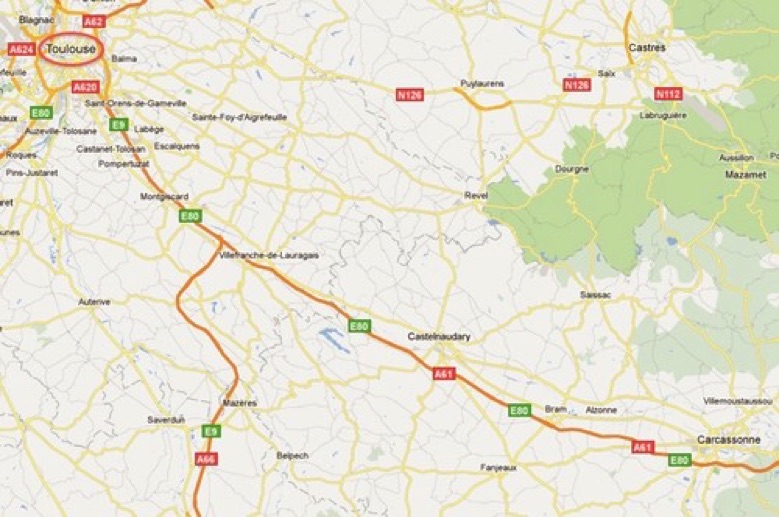When we first heard about the barge-handling courses on Vertrouwen, the name we kept hearing about was Roger van Dyken. After all, he had written the book "Barging in Europe" and he was the one referred to in "Just Imagine" and elsewhere. So we emailed Roger and chased him for several weeks, and then found out that Vertrouwen (on which the training courses were run) was now owned by a syndicate who took turns in using the barge. He was therefore unsure whether it would be available for training courses when we wanted them in April 2011.
As we were making these enquiries, we came across another Australian couple (actually a Kiwi and a Dutch lady who had both lived in Australia for many years) who had responded to my DBA enquiries about registering Kanumbra on the Australian Register of Ships. They were taking a much bigger step than us, by selling up in Australia and moving to Europe with a few suitcases, to buy a barge and live the cruising life (brave souls!). It also turned out that Bruce and Anne were also wanting to do the van Dyken course, so we joined forces and jointly chased Roger.
Eventually, Roger responded that the barge would be available for training in April, but that he would not be! So he put us in the good hands of Jerry Crosby, one of the co-owners, who would run the course according to "the book of Roger".
Vertrouwen
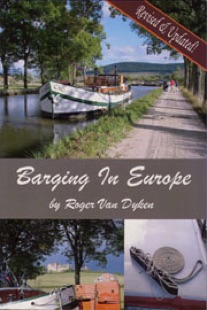
So, in April 2011, we met up in person with Bruce and Anne for the first time (all our contact had previously been by email) and travelled by train from Moissac to Bram, where the course started. Bram is a small town on the Canal du Midi, between Toulouse and Carcassonne. The idea was to cruise from Bram to Toulouse over the next 6 days, four days with "up-locks" and then two days with "down-locks". Each night we would simply moor at the bank and sleep on-board, and go find whatever was happening in the local towns (including buying provisions etc).
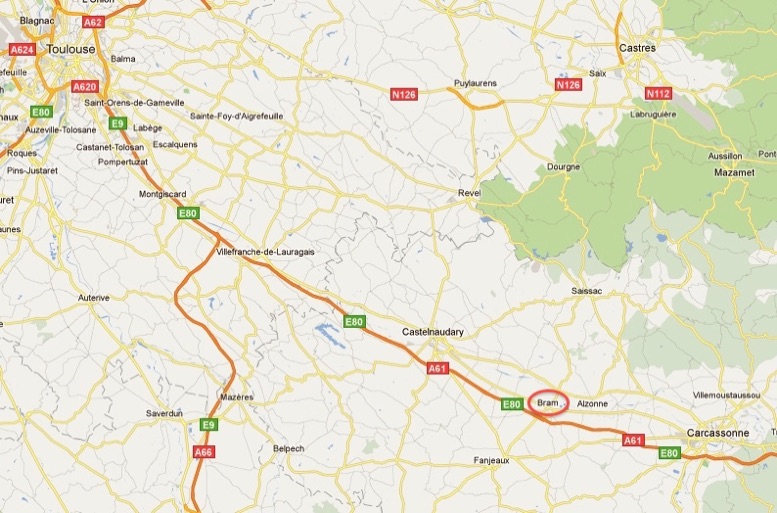
This slow speed compounded a little problem we had as we entered Toulouse. Bruce, Anne, Rita and I were due to take a train from Toulouse to Moissac that afternoon, and we were rapidly running out of time. With very little time left we tied up in Toulouse, then tried to find a taxi to get to the train station. As the time for the train came and went, we were still looking for a taxi!
So, when one finally came along, we just shrugged and asked him to take us to Moissac. No point getting upset. The lessons learnt during the previous week had taught us to relax and just take life as it comes (-:
Vertrouwen is a Dutch Klipper Aak, built of riveted steel in Leeuwarden in The Netherlands in 1908, and converted to pleasure cruising in the 1970's. She is 21 metres long and weighs about 60 tonnes. She has a draft of 1.3 metres, an air draft of 2.75 metres and a beam of 4.3 metres. She has a 165hp DAF diesel engine. Importantly, as we were to learn, she has no bowthruster.
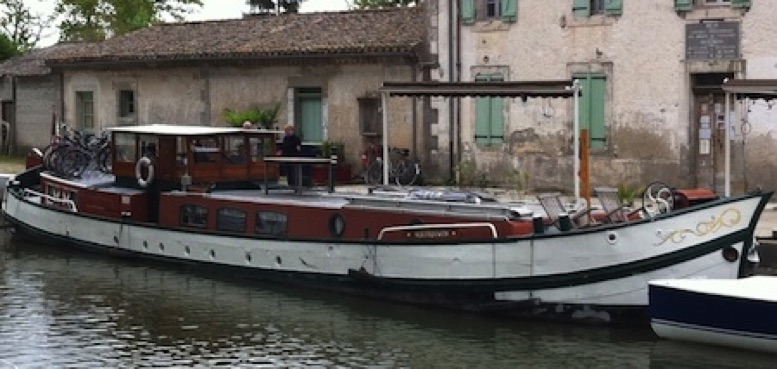
By way of contrast, Kanumbra is a Piper Replica Dutch Barge built of welded steel in Stoke on Trent in the UK in 2006. She is 17 metres long and weighs about 25 tonnes. She has a draft of 0.70 metres, an air draft of 2.8 metres and a beam of 3.8 metres. She has a 135hp Perkins Sabre diesel engine. Importantly, she has a bowthruster.
We were joined in the class by an American couple and by Jerry's wife, Kathryn. Jerry split us into two groups (boys and girls), with one person from one of the groups being skipper, the other two in that group assisting with relaying instructions, while the three in the other group would be responsible for the ropework on deck. Jerry would generally stay with the skipper-in-training at the wheel, but would sometimes go for a walk around the deck to see how everyone else was going.

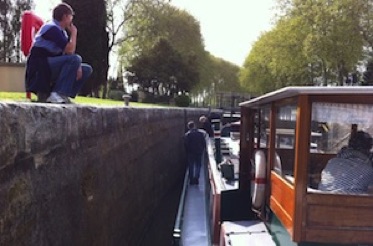
This sounded like a good idea at the time, but as we found out at the first lock the system fell apart a bit, with everyone except the skipper (who was busy just trying to get the barge into the damned lock - I drew the short straw and got to be the skipper for the first session) running around like headless chooks or yelling orders at everyone else. Oh, the joy of barging with "too many cooks". With time and practice, everything settled down a bit, with much less yelling and with some just preferring to go missing when there was work to be done on deck.
After an interesting first day, we simply pulled over to the bank and tied up (after we had learned a bit about hammering in spikes and tieing "stringers" to keep the barge from moving around in the night). This experience was to serve us well later in the year, as we discovered the joy of just stopping anywhere for the night (Bruce and Anne have not been so lucky in the Netherlands, where such behaviour is frowned upon!).
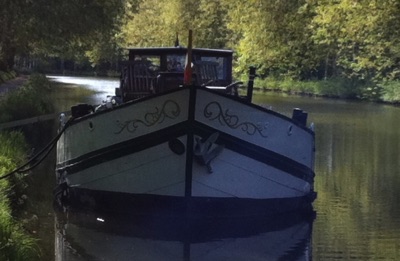

Once everything was made secure, Rita and I then pinched two of the bikes on board and headed back to a lock we had recently come through at La Peyruque, where we had seen an interesting shop. Rita's French was used to good effect, as we learned the history of their little shop in the old eclusier's (lock-keeper's) cottage, discussed the credential's of the local wine and made an appointment to pick up fresh bread in the morning (a French tradition that I quite liked). We also picked up a ceramic plaque which now hangs in the galley of Kanumbra as a reminder of our first day of barging.
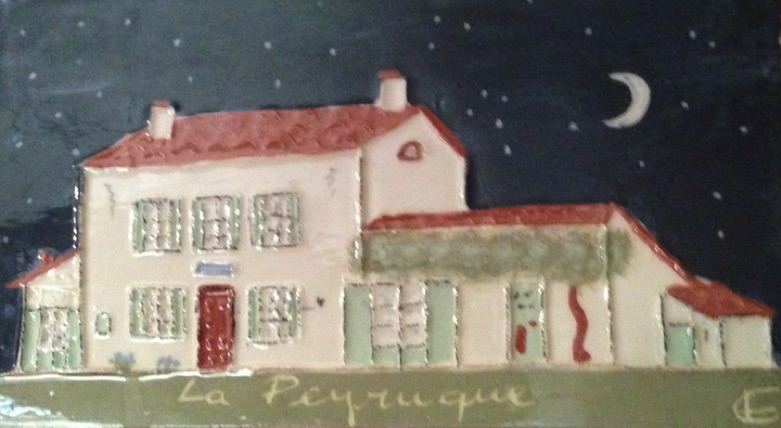
The next morning we pedalled back to the shop for the bread, had a leisurely breakfast, reviewed the first day's adventures/misadventures and then headed off again. This time it was the girl's turn to be skipper and Rita got first go, with Jerry offering calm but sage advance as required. Jerry had a great teaching style, even if he did seem a trifle laconic to begin with! He never intervened, but just suggested what you might perhaps do next.
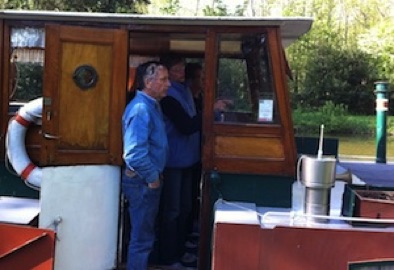
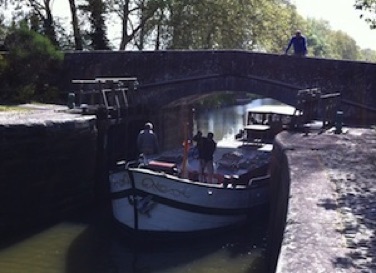
After a bit of straight-line cruising, Rita's first lock finally arrived. She was just a trifle nervous (for months leading up to April, she had told me how she wouldn't be able to steer the boat). But her first attempt was near perfect. Straight through the gap under the watchful eye of the eclusier, without even touching the sides.
She did all the right things by checking that she had cleared the sill at the back of the lock before giving the order to the crew to secure the barge to the bollards (the sill being a stone wall just under water level a metre of so from the back of the lock - don't want to get hung up on that in a descending lock - even though we were currently going uphill).
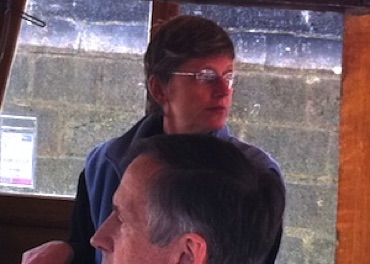
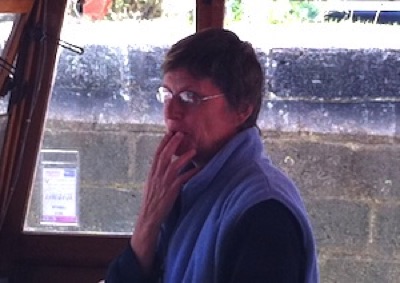
But like everyone, she was not perfect, and managed to give the side wall of the lock a tiny nudge. But nudges and bumps are just a part of going through locks. Luckily they are big strong steel barges! With practice over the years, our nudges will decline (but never really be eliminated).
As the day progressed, everyone had their turn of skippering with Anne taking control as we approached the city of Castelnaudary (famous for the dish of cassoulet - a rich, slow-cooked casserole containing haricot beans and meat of all types (pork sausage, goose, duck)).

At the entrance to Castelnaudary, we encountered our first double-lock (it turned out to be a quadruple-lock). Anne took us carefully into the bottom lock, which we negotiated without problems. We then moved up to the second of the locks, where we tied up and awaited our fate.
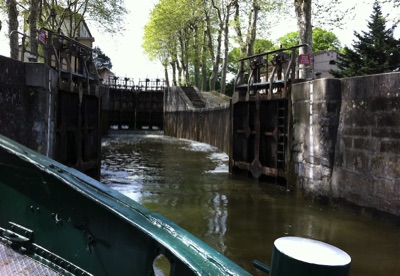
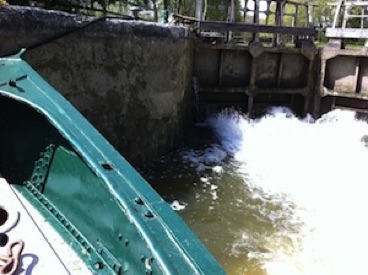
In a bid to get us through the locks as quickly as possible (I think lunch-time was rapidly approaching), the eclusier decided to fill the top lock a bit quicker, with a high degree of turbulence as the water raced from the top gate into the lock. Because of the rounded shape of the locks on the Midi, we were able to keep our bow tucked well into the side of the lock and out of the direct flow of the incoming rush of water.
However, as we were about to learn the hard way, when that water gets to the back of the lock it has nowhere to go except to turn around and start coming back up the lock. This catches the stern, which is blunter and more out in the middle of the lock, and pushes the barge forward with great force. All of this should not be a problem as the ropes should control the movement of the barge. However, in this case, the stern rope had been tied fast to the rear bollard, instead of just being wrapped around the bollard and held fast. This had the effect of transferring all the force from the barge directly to the bollard on the lock, pulling it clean out of the ground. Not surprisingly, the eclusier was not impressed (but also realised it was partly his fault for releasing the water so quickly). Once again, Rita's fluent French came in handy!
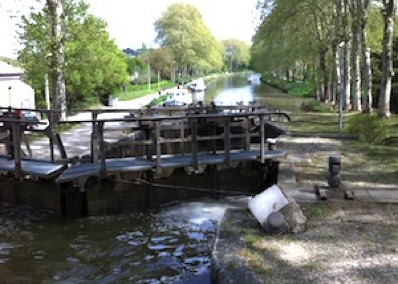
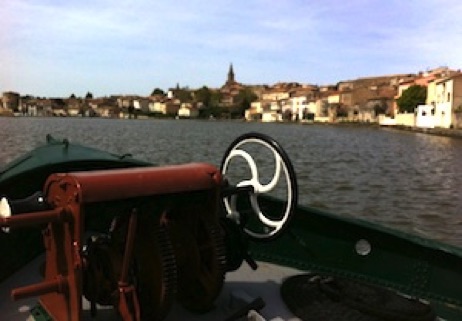
Having escaped the lock, we then proceeded into the relative calm of the wide-open Castelnaudary Basin. Perhaps as a way of restoring confidence in everyone, Jerry instructed Anne in how to do 360 degree turns using just the throttle, the rudder and the effect of prop walk (did I mention that Vertrouwen does not have a bowthruster?). After a little bit of practice, Anne was spinning us in circles.
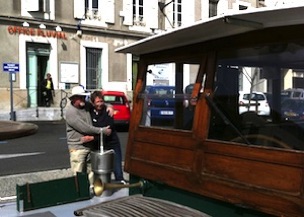
By the time we had tied up outside the Office Fluvial in Castelnaudary, Anne was in need of a little congratulations from Bruce! That evening, we all went into town to sample the famous Cassoulet, and a great time was had by all (even if Bruce and Anne did sneak off for a little romantic dinner by themselves!).
On leaving Castelnaudary the next day, we were to discover something we hadn't seen for a long time - solitude. The chance to just sit and do nothing and watch the passing scenery is a benefit of barging that we had not fully anticipated. The video below captures some of the feeling as you just cruise down the canal, never quite knowing (or caring) what might be around the next bend.
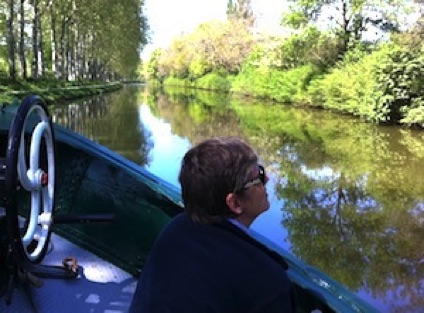
Later that afternoon, we cycled forward to the headwaters of the Canal du Midi, where water entered from a reservoir and flowed both ways into the canal - one way to the Mediterranean and the other to the Atlantic. From here on, all the locks would be downhill to Toulouse, thus teaching us a different set of barging skills. The headwaters enter the canal within a beautiful parkland setting, with an monument tribute to Pierre-Paul Riquet, the builder of the canal in the 17th century.
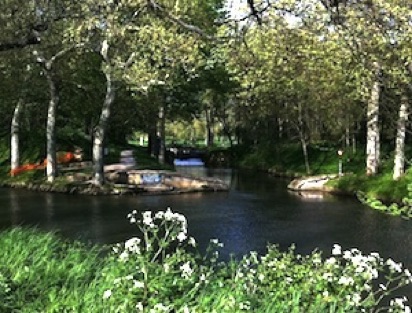
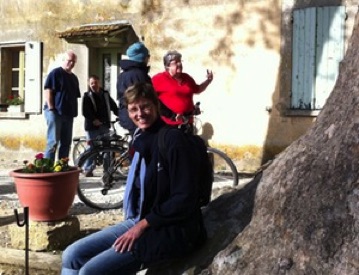
Nearby, at the Ecluse De L'Ocean, the first downhill lock on the way to Toulouse, we ran into a retired American couple who had bought the old lock-keepers cottage and were restoring is as a museum to the history of the canal and the role played by various people such as Thomas Jefferson. Jerry and Kathryn were pleased to meet up with such an interesting American couple!
That evening, Rita and I took the lead from Bruce and Anne the previous night and headed off on our own on our bikes to find a restaurant in the nearby town of Labastide d'Anjou, which we had heard made the absolute best Cassoulet in the district. We found ourselves the only guests when we arrived at 6pm, and had a lovely evening to ourselves. The cassoulet was indeed good. However, towards the end of our meal, we heard familiar voices from the rest of the Vertrouwen people, who had also found the same restaurant. Eventually, we finished up, jumped on our bikes and wobbled back to the barge in the middle of the night.
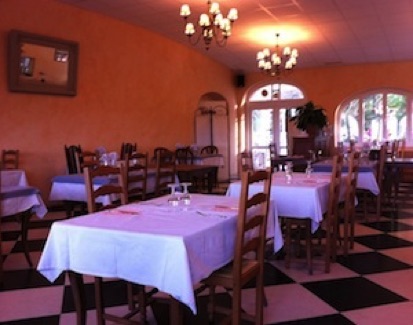
Another nice thing about barging is just be able to lie back on the roof of the cabin and watch the trees go by.
The course was now more than half completed as we approached Lauragais. We had learned a lot, but still had much more to learn. We still had trouble keeping Vertrouwen in a straight line, and often tended to drift out in the corners. On several occasions, we ran aground (luckily mostly in mud and silt). On one occasion, the eclusier kept waving us into the next lock, but we couldn't move. He came down on his bike, then went back and let more water into our stretch of the canal. This lifted us just enough to get clear of the bank!

Near Lauragais, we came across an interesting port that also served as a rest area for the highway that passed close to the canal at that point. It looked very grand, with its restaurants, buildings and wharfs, but we just kept on cruising by.
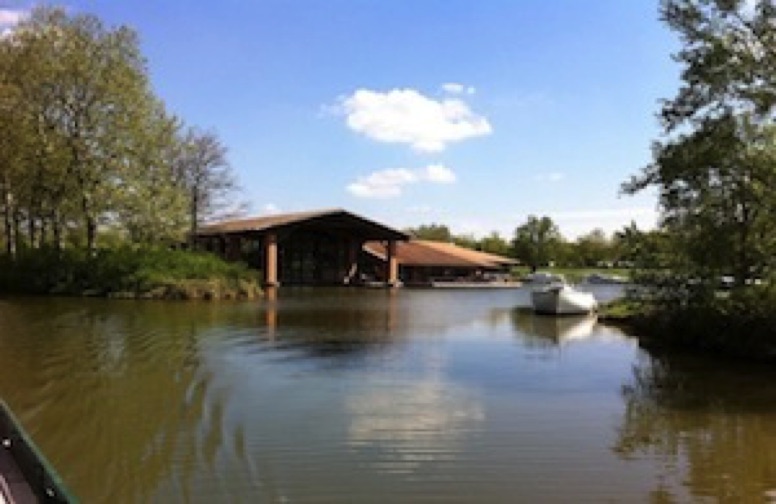
At the Ecluse de Renneville, one advantage of the shape of the Midi locks become apparent as we shared space with a couple of French-Canadians in a much smaller boat. But, as you can see the lock could easily have held two barges the size of Vertrouwen.
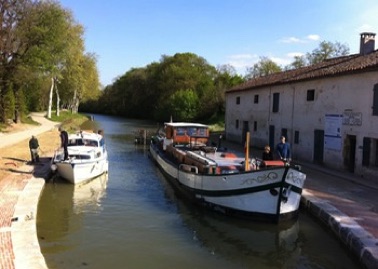
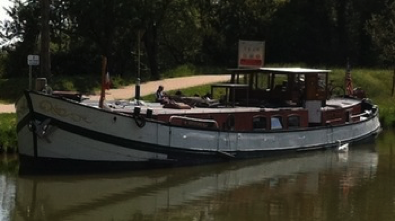
For the rest of the trip, while we continued to accumulate experience, we began to appreciate the small joys of barging, like feeding the swans when we had tied up for lunch.
Or admiring the variety of blue shutters in pretty canalside villages.

Or learning the virtues of patience when the lock gate won't open and the eclusier has already gone for their 2-hour lunch break.
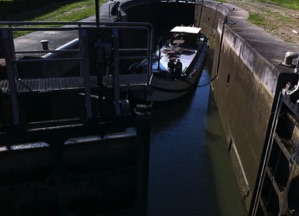
We realised that the canals are useful not just for barges. We saw that cyclists were prolific users of the beautiful (flat) cycle paths that follow the canal from Bordeaux to Beziers, while all sizes and shapes of walkers and runners were our frequent companions.
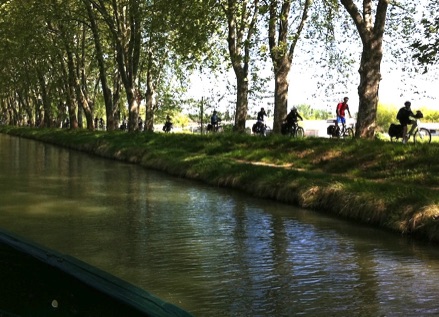
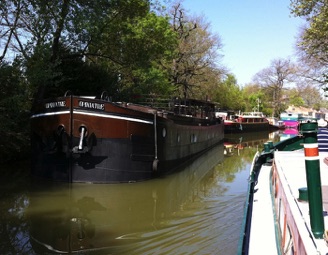
And then all too soon, we started to see lots of barges moored along the edge of the canal, as we neared the outskirts of Toulouse. A strict speed limit of 3kph was enforced in this area to minimise wake disturbance for the moored barges.
